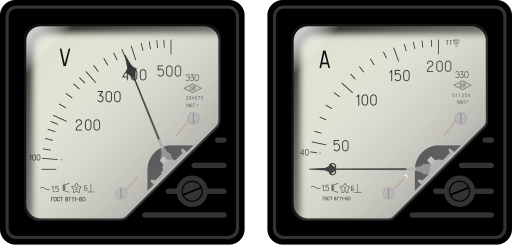OCR Specification focus:
‘Construct clear circuit diagrams using these standard symbols.’
Drawing circuit diagrams is an essential skill in A-Level Physics, enabling clear communication of how components are connected and how current flows through electrical systems. These diagrams use agreed standardised symbols to represent electrical components accurately and unambiguously, following conventions that allow scientists and engineers to interpret and construct circuits consistently.
Importance of Circuit Diagrams
Circuit diagrams are schematic representations of electrical circuits. They provide a simplified, visual model that allows students, technicians, and engineers to understand and construct physical circuits safely and efficiently. Each symbol represents a specific component, and the connections between them show the path of current and the relationship of potential difference throughout the circuit.
A well-drawn circuit diagram ensures:
Easy interpretation of how current flows and components interact.
Safe and accurate construction of circuits in practical work.
Effective troubleshooting and modification of existing circuits.
Communication of design intentions in professional and academic contexts.
Conventions in Drawing Circuit Diagrams
To meet the OCR specification, students must construct clear circuit diagrams using standard symbols. These conventions ensure universal understanding.
1. Straight Lines for Wires
Circuit connections should be drawn using straight lines representing conducting wires. Lines meet at right angles, giving a tidy and readable structure.
2. Junctions and Connections
When wires are connected, a solid dot is placed at the junction.
When wires cross without connecting, no dot is used, or a small bridge is drawn to indicate no connection.
3. Orientation and Layout
Circuits are generally drawn horizontally or vertically.
Components should be evenly spaced to prevent overcrowding.
Inputs (e.g. power supplies) are often placed on the left, and outputs (e.g. lamps or meters) on the right.
4. Labels and Values
Each component may include a label or value:
Resistors: resistance in ohms (Ω).
Power supplies: voltage in volts (V).
Meters: type of measurement (A for ammeter, V for voltmeter).
Labelling ensures diagrams convey quantitative information as well as structure.
Circuit Diagram: A simplified, symbolic representation of an electrical circuit showing components and their connections using standard symbols.
Circuit diagrams are not to scale and omit physical details, focusing instead on electrical relationships and functionality.
Key Practices in Constructing Circuit Diagrams
1. Planning the Circuit
Before drawing:
Identify the components needed.
Determine their sequence and interconnections.
Sketch a rough layout to ensure clarity and logical flow.
2. Using Standard Symbols
Use symbols defined by international standards such as BS EN 60617.

A clear diagram with an ammeter (A) in series with the circuit and a voltmeter (V) in parallel across a component. This matches the standard convention students must reproduce in neat schematics and when wiring practicals. The schematic uses standard symbols only; no extra theory beyond placement is included. Source.
These include:
Cell and battery
Resistor (fixed and variable)
Switch (open, closed, push, toggle)
Lamp or bulb
Diode and LED
Voltmeter and ammeter
Correct use of these ensures the diagram adheres to recognised 16–19 science guidance.
3. Representing Meters Correctly
Ammeter: connected in series to measure current.
Voltmeter: connected in parallel to measure potential difference.
Meters are shown with circular symbols labelled ‘A’ or ‘V’ respectively.
4. Drawing Parallel and Series Circuits
Series circuits: components connected end-to-end, sharing current.
Parallel circuits: branches allow current to split and rejoin.
These arrangements should be drawn distinctly, showing how potential difference and current vary across branches.

A schematic showing one branch in series and multiple branches in parallel, using straight conductors and right-angle junctions. The diagram emphasises the distinct topologies used when laying out circuits on paper. Any additional styling (e.g. lamp glyphs) is purely illustrative and aligns with standard symbols. Source.
Clarity and Readability in Diagrams
A high-quality circuit diagram must be clear, uncluttered, and logically organised. Follow these principles:
Avoid diagonal lines, which make the layout harder to interpret.
Minimise line crossings; where unavoidable, indicate non-connections clearly.
Keep component spacing consistent to improve readability.
Label switches and sensors with brief identifiers (e.g. S₁, LDR₁).
Good diagrams allow others to recreate the physical setup without confusion or error.
Standard Electrical Symbol: A recognised pictorial representation used internationally to denote a specific electrical component within a circuit diagram.
This standardisation removes ambiguity between circuit designers, manufacturers, and examiners.
Best Practice for Hand-Drawn Diagrams
Although many modern diagrams are created digitally, OCR examinations often require hand-drawn circuits. Follow these best practices:
Use a pencil and ruler for straight lines and clean presentation.
Ensure junction dots are large enough to see clearly.
Write component labels neatly and horizontally.
Use consistent spacing and avoid unnecessary curves.
Accuracy in drawing reflects understanding of the circuit’s physical arrangement.
Translating from Physical Circuits to Diagrams
When observing or constructing a real circuit:
Identify each component and connection before diagramming.
Translate the setup into standard symbols in their correct arrangement.
Check the direction of current flow from positive to negative terminal (conventional current).
Conversely, when building from a diagram:
Follow the connections precisely as drawn.
Verify power supply polarity and component orientation (especially for diodes and LEDs).
Use the diagram as a blueprint for assembly, ensuring safety and correctness.
Use of Digital Tools
Digital circuit design platforms such as Crocodile Physics, PhET, or CircuitLab help students practise drawing neat, accurate diagrams using drag-and-drop symbols. While these tools are excellent for learning, students should still master manual construction for written assessments.
Common Mistakes to Avoid
Using non-standard or improvised symbols.
Drawing messy, angled, or unclear connections.
Omitting junction dots, causing misinterpretation.
Incorrectly connecting meters (especially voltmeters in series).
Reversing polarity for diodes or LEDs.
Avoiding these ensures your diagrams meet the precision expected in A-Level Physics.
Good Diagramming Conventions Summary
To summarise the key expectations for OCR:
Use standard circuit symbols exclusively.
Draw straight, right-angled connections.
Label and annotate clearly where appropriate.
Present series and parallel layouts distinctly.
Ensure clarity, accuracy, and completeness.
FAQ
Standardised symbols ensure universal understanding across languages and disciplines. A resistor symbol means the same thing whether viewed by an engineer in the UK or a physicist in Japan.
Pictures of real components would vary in size, design, and manufacturer, making diagrams harder to interpret. Using symbols removes ambiguity and keeps the focus on electrical function rather than physical appearance.
Standardisation also allows quick sketching and easier modification of designs during practical work or theoretical planning.
Typical errors include:
Drawing wires that meet without adding a junction dot.
Misplacing meters (e.g. voltmeter in series).
Using non-standard or improvised symbols.
Drawing diagonal connections that confuse the layout.
Maintaining straight, right-angled connections and consistent spacing avoids these issues. Clarity and accuracy are prioritised over artistic neatness.
Begin by identifying the main supply line from the power source.
Arrange each parallel branch vertically or horizontally with clear separation.
Place the shared connection points (junctions) at neat right angles.
Keep the diagram balanced, avoiding overlapping wires.
A consistent grid-like structure makes it easier to see how current divides and recombines, and reduces the risk of wiring errors when building the circuit.
Circular meter symbols are used because they are simple, compact, and visually distinct.
The circle represents the measuring instrument, while the letter inside indicates the quantity measured (A or V).
This convention avoids confusion with resistors or other components that use rectangular or zigzag symbols.
Historically, circular symbols were introduced to reflect the appearance of analogue meter dials, a design still retained for clarity and continuity.
In professional and examination contexts, diagrams should be monochrome and rely solely on shape and symbol, not colour.
However, colour can be useful for personal study or digital learning to highlight:
Current direction (e.g. red for positive, blue for negative).
Distinct circuit branches.
Components of interest during explanation.
When submitting assessed work, always ensure the diagram remains clear and accurate in black and white printouts.
Practice Questions
Question 1 (2 marks)
A student is asked to draw a circuit diagram showing a battery connected in series with a lamp and a switch.
(a) Sketch the circuit diagram clearly using standard electrical symbols.
(b) State one convention that must be followed when drawing circuit diagrams.
Mark scheme
(a) 1 mark for correct use of standard symbols for battery, lamp, and switch.
(a) 1 mark for correct series connection (battery → switch → lamp → return to battery).
(b) 1 mark for any valid convention, such as:
Using straight lines for connecting wires.
Ensuring right-angled junctions.
Labelling components where necessary.
(Maximum 2 marks total.)
Question 2 (5 marks)
A student is constructing a circuit diagram for an experiment to measure the current through a resistor and the potential difference across it.
(a) State which meters should be included in the circuit and how each should be connected. (2 marks)
(b) Draw a clear circuit diagram using the correct standard symbols. (2 marks)
(c) Explain why following standard circuit diagram conventions is important in physics communication. (1 mark)
Mark scheme
(a) 1 mark for identifying ammeter and voltmeter.
(a) 1 mark for describing correct connections: ammeter in series, voltmeter in parallel across the resistor.
(b) 1 mark for including correct symbols for all components (cell/battery, resistor, ammeter, voltmeter).
(b) 1 mark for correct arrangement: ammeter in series with resistor; voltmeter connected across resistor.
(c) 1 mark for explanation of importance, such as:
Ensures clarity and universal understanding of circuit layout.
Prevents misinterpretation and construction errors in practical setups.
(Maximum 5 marks total.)

